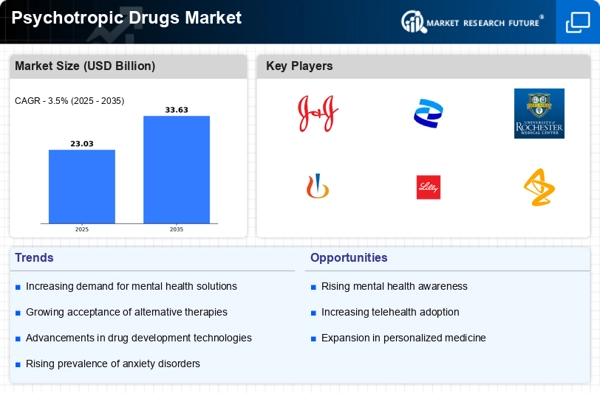Innovations in Drug Development
Innovations in drug development play a crucial role in shaping the Psychotropic Drugs Market. Advances in pharmacogenomics and biotechnology have led to the creation of more targeted therapies, which may enhance treatment efficacy and reduce side effects. The introduction of novel compounds and formulations, such as long-acting injectables, has expanded the therapeutic options available for patients. Furthermore, the increasing investment in research and development by pharmaceutical companies indicates a commitment to addressing unmet medical needs in mental health. In 2023, the psychotropic drug segment accounted for a substantial share of the overall pharmaceutical market, reflecting the growing recognition of the importance of mental health treatment. As these innovations continue to emerge, they are expected to drive the Psychotropic Drugs Market forward, offering new hope for patients and healthcare providers alike.
Growing Acceptance of Telepsychiatry
The growing acceptance of telepsychiatry is reshaping the landscape of the Psychotropic Drugs Market. As technology continues to advance, more patients are turning to telehealth services for mental health consultations and follow-ups. This shift not only increases access to care but also encourages adherence to prescribed psychotropic medications. Studies have shown that patients who engage in telepsychiatry are more likely to maintain their treatment regimens, which can lead to improved health outcomes. The convenience of remote consultations may also reduce barriers to seeking help, particularly in underserved areas. Consequently, the integration of telepsychiatry into mental health care is expected to drive demand for psychotropic drugs, as more individuals seek effective treatment options through these innovative platforms. This trend highlights the evolving nature of mental health care delivery and its impact on the Psychotropic Drugs Market.
Rising Prevalence of Mental Health Disorders
The increasing prevalence of mental health disorders is a primary driver of the Psychotropic Drugs Market. According to recent estimates, nearly one in four individuals experiences a mental health issue at some point in their lives. This rising incidence necessitates effective treatment options, thereby propelling demand for psychotropic medications. The World Health Organization has indicated that depression and anxiety disorders are among the leading causes of disability worldwide. As awareness of mental health issues grows, more individuals seek treatment, further stimulating the Psychotropic Drugs Market. The expansion of healthcare services and insurance coverage for mental health treatments also contributes to this trend, as it allows more patients to access necessary medications. Consequently, the market is likely to witness sustained growth as the need for effective psychotropic drugs continues to rise.
Increased Investment in Mental Health Research
Increased investment in mental health research is a pivotal driver of the Psychotropic Drugs Market. Governments, private organizations, and philanthropic entities are allocating substantial resources to understand mental health disorders better and develop effective treatments. This surge in funding has led to breakthroughs in understanding the neurobiological underpinnings of various mental health conditions, paving the way for the development of new psychotropic medications. In recent years, funding for mental health research has seen a notable increase, with several initiatives aimed at addressing the gaps in treatment options. As research continues to advance, it is likely that new and more effective psychotropic drugs will emerge, further stimulating the market. This focus on research not only enhances the understanding of mental health but also fosters innovation within the Psychotropic Drugs Market.
Regulatory Support for Mental Health Initiatives
Regulatory support for mental health initiatives significantly influences the Psychotropic Drugs Market. Governments and health organizations are increasingly recognizing the importance of mental health, leading to the implementation of policies that promote access to mental health care and treatment. For instance, various countries have enacted legislation aimed at improving mental health services and reducing stigma associated with mental illness. This regulatory environment encourages pharmaceutical companies to invest in the development of psychotropic drugs, as they can expect a more favorable market landscape. Additionally, initiatives that facilitate faster approval processes for new medications can enhance the availability of innovative treatments. As a result, the Psychotropic Drugs Market is likely to benefit from these supportive measures, which aim to improve mental health outcomes for populations worldwide.


















Leave a Comment